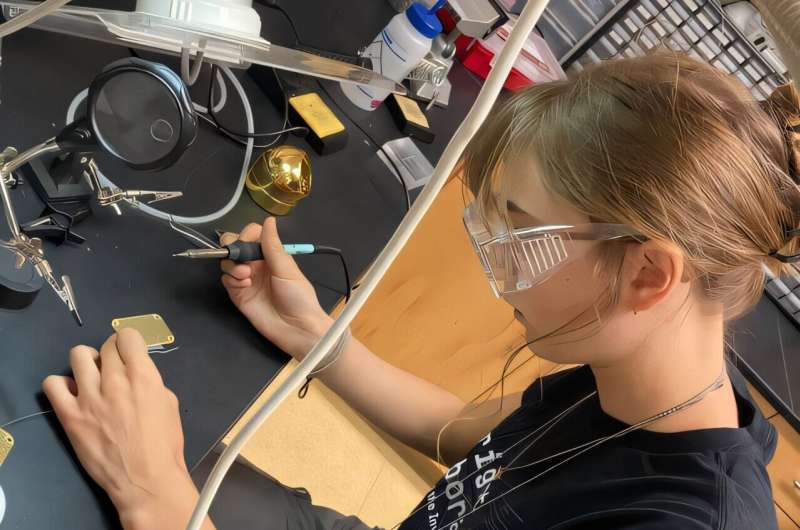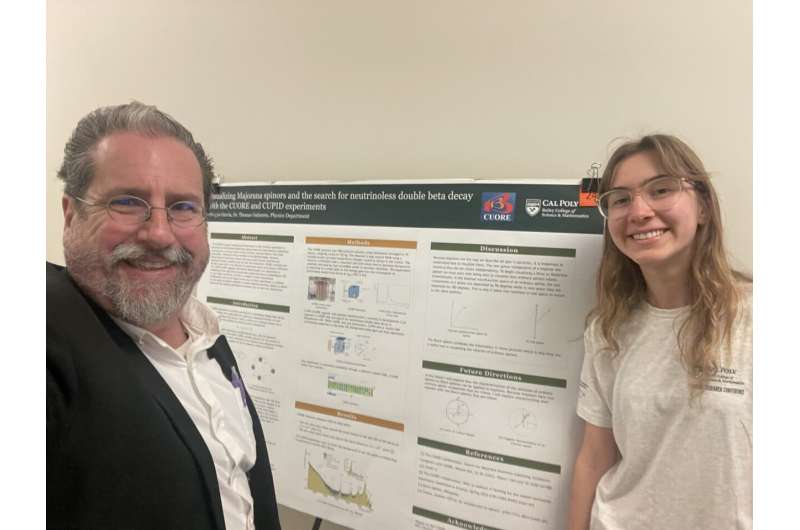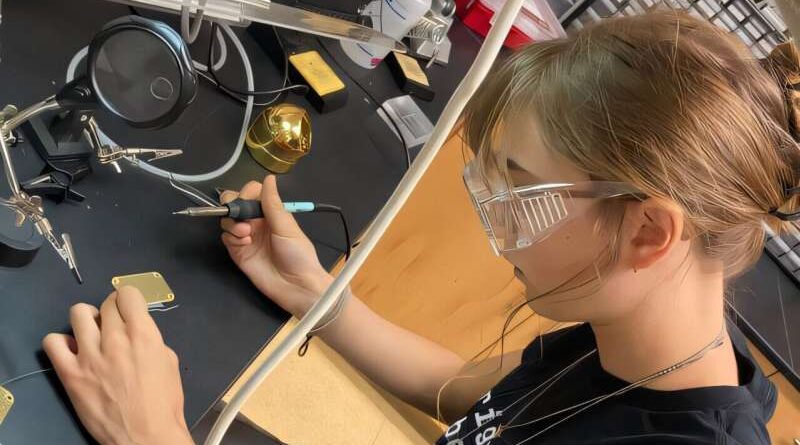Secrets of the universe explored by a professor, students in an underground laboratory in Italy

Cal Poly physics major Reagen Garcia has collaborated with a team of scientists on ongoing particle physics work in Italy as part of the CUPID (CUORE Upgrade with Particle Identification) program. Credit: Cal Poly
In an underground laboratory in the Italian mountains with the coldest temperature known to exist in the universe, international teams of scientists are trying to solve one of the greatest mysteries by the best of physics.
And Cal Poly physics professor Thomas Gutierrez is one of more than 150 international scientists participating in the research.
At the Gran Sasso National Laboratory near Assergi, Italy, located 80 kilometers northeast of Rome at the foot of the Apennine mountains, researchers from universities including UC Berkeley, UCLA, Yale, MIT, Johns Hopkins , and Cal Poly, as well as Europe and Asia Campuses.
Along with other scientists, Gutierrez and his team of Cal Poly students are exploring unproven theories related to nuclear decay, also known as radioactive decay, the process in which the nucleus of an atom does not stability that loses energy through radiation. Their work tries to help explain exactly why the universe is full of matter, and to solve some of the mysteries that have puzzled scientists for generations.
“If you find something that defies the laws of physics, then that’s a discovery,” Gutierrez said. “Right now we’re looking for a type of nuclear decay that’s currently forbidden by the laws of physics. It shouldn’t happen. So, if it does happen, which is what we want, it tells you a lot about the way the world works. about it.”

Cal Poly physics professor Thomas Gutierrez (left) and Cal Poly physics graduate student Reagen Garcia collaborate on research related to the CUPID (CUORE Upgrade with Particle Identification) program, which includes a group of international scientists. Credit: Cal Poly
The research continues the scientific cooperation started under the international program CUORE (Cryogenic Underground Observatory for Rare Events), which is now called CUPID (CUORE Upgrade with Particle Identification). The word “cuore” means heart in Italian; hence the abbreviation that uses “cupid” for the next, most recent stage of the program.
Gutierrez’s research area focuses on neutrinos, which are tiny particles with very little mass. Because they fill the universe during big explosions and travel at close to the speed of light, neutrinos can also come from violent explosions like exploding stars.
Neutrinos are mostly created by radioactive decay. Because they are so weak and neutral, they can help explain the universe’s differences in matter and antimatter.
In modern physics, all particles have antiparticles, their antimatter: electrons have antielectrons (positrons), quarks have antiquarks, and neutrons and protons (which make up the nuclei of atoms) have anti-antiprotons.
“Under the laws of physics, there would have been equal amounts of matter and antimatter, and they would have been eliminated, gone, and we shouldn’t be here anymore,” Gutierrez said. . “Yet this scar that remains is us. Why are we even here? Why is that scar there at all? Now that’s a strange thing.”
Under the classical theory of science, neutrinos—which are neutral in nature—may be their antiparticles. But this theory has never been proven. The CUPID mission hopes to reveal the possibility of neutrinoless double-beta decay, a radioactive process in which the nucleus of an atom releases two electrons but no neutrinos. Seeing this decay would support the theory that neutrinos are their antiparticles.
“If neutrinoless double beta decay occurs, it tells us all this information about the fundamentals of matter, not just this matter, but all matter that exists,” Gutierrez said. “This is very strong.”
Get the latest science, technology and space news 100,000 subscribers who rely on Phys.org for daily information. Sign up for our free newsletter and get the latest information on breakthroughs, updates, and important research—a day or a week.
Gutierrez and an international scientific team are collaborating on the study of tellurium dioxide crystals, a mixture of the elements tellurium and oxygen.
“There is a theory that the isotope of tellurium can undergo double beta decay,” Gutierrez said.
About a third of the nuclei in this tellurium crystal chunk are the right isotope, Gutierrez said.
“The idea is to use a detector inside this crystal to measure its decay,” Gutierrez said. “It will add a lot of energy, raise the temperature, which we can see. With this test, at best, what we would like to say is whether or not the neutrino is an antiparticle.”
The Italian laboratory shields cosmic rays and other natural radioactivity with nearly a kilometer of rock in each direction and a protective, six-inch-thick shield made of with boiled lead taken from an ancient Roman shipwreck.
Ancient lead that was used as a shield for laboratory research has no radioactive properties due to a natural process that takes hundreds of years to occur, showing the effectiveness of hundreds of years. for science.
The Italian center is the largest underground research center in the world. The probe’s cold conditions are designed for temperatures of about 10 milliKelvin or -441.74 degrees Fahrenheit, the coldest sound of its size anywhere in the universe. Such cold temperatures are useful in particle science because when particles are cooled, they move much more slowly, enabling scientists to study their behavior more precisely.
People are still “hitting their heads against the wall trying to understand” the concepts of antimatter and matter, and how neutrinos might be involved, Gutierrez said.
“There are many different methods that people have been testing, but about 30 years ago this idea that if this decomposition can happen, then it tells us about the properties of the material, and that would suggest that the universe actually favors matter over antimatter,” Gutierrez said.
Cal Poly students have already participated and will continue to do so, including Reagen Garcia, a physics major, from Morro Bay, California. Part of his job involves making modifications to the remote detector operation of the experiments taking place in Italy.
“CUORE needs to be constantly monitored, so changes in remote device performance are an important part of testing,” Garcia said. Garcia also did a summer internship at Yale University’s Wright Laboratory, a co-facility for the CUPID experiment, where Garcia tested the particle detector.
“It was exciting to be a part of the detailed, specific details of the trial design,” Garcia said. “This past summer at Yale was the most exciting and rewarding experience I have had the opportunity to be a part of.”
Offered by California Polytechnic State University
Excerpt: Mysteries of the universe explored by professor, students of Italian underground lab (2024, November 22) Retrieved November 22, 2024 from https://phys.org/news/2024-11-mysteries- universe-explored-professor-students.html
This document is subject to copyright. Except for any legitimate activity for the purpose of private study or research, no part may be reproduced without written permission. Content is provided for informational purposes only.
#Secrets #universe #explored #professor #students #underground #laboratory #Italy
